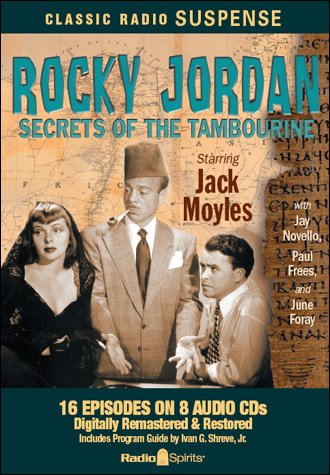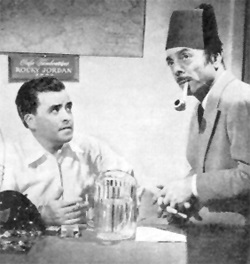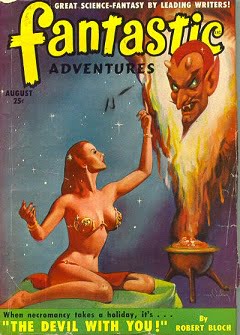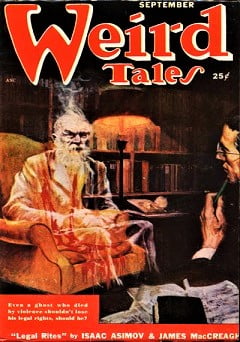
 Rocky Jordan aired “The Broken Wing” on August 6, 1950. This is but the tenth Rocky Jordan episode we have showecased, the last being two years ago in August of 2017. Borrowed from a previous introduction for the benefit of new listeners unfamiliar with the Rocky Jordan program, here is the show’s background. Rocky Jordan ran from October 21, 1948 through September 5, 1950 and starred Jack Moyles as Rocky Jordan. There were several iterations of the show, the first of which aired in 1945 under the title A Man Named Jordan. Only two episodes of this early precursor are known to still exist. This version was set in Istanbul, Turkey but was otherwise the same as its successor. An attempt to revive the series with famed Hollywood actor George Raft aired for one season from 1950-51. A couple of half-hearted attempts were made at further revivals in 1955 and ’57, but none of these fifteen-minute episodes survives.
Rocky Jordan aired “The Broken Wing” on August 6, 1950. This is but the tenth Rocky Jordan episode we have showecased, the last being two years ago in August of 2017. Borrowed from a previous introduction for the benefit of new listeners unfamiliar with the Rocky Jordan program, here is the show’s background. Rocky Jordan ran from October 21, 1948 through September 5, 1950 and starred Jack Moyles as Rocky Jordan. There were several iterations of the show, the first of which aired in 1945 under the title A Man Named Jordan. Only two episodes of this early precursor are known to still exist. This version was set in Istanbul, Turkey but was otherwise the same as its successor. An attempt to revive the series with famed Hollywood actor George Raft aired for one season from 1950-51. A couple of half-hearted attempts were made at further revivals in 1955 and ’57, but none of these fifteen-minute episodes survives.
 Rocky Jordan was modeled on the classic, much revered movie Casablanca, which premiered in New York on November 26, 1942 and then in general release on January 23, 1943. Casablanca starred Humphrey Bogart as Rick Blaine, the American exile who ran Rick’s Cafe Americain in Casablanca, Morocco, an unallied country during world War II located in northwest Africa and bordering the Mediterranean Sea. Rocky Jordan is set in Cairo, Egypt, in northeast Africa, said country also bordering the Mediterranean. Rocky calls St. Louis home (but was chased abroad by his enemies), whereas Rick hailed from New York; both are intimated to have shady pasts. The counterpart to Rick’s Cafe Americain is Rocky Jordan’s Cafe Tambourine, not far from the “mosque Sultan Hassan,” (photo above right) where Rocky finds himself routinely involved with “crime, mystery, and beautiful women.” Much like Rick’s Cafe Americain which is set during WW II, Jordan’s Cafe Tambourine, while set a few short years following the war, is a magnet for all ethnicities and types, from the respectable to the rogue.
Rocky Jordan was modeled on the classic, much revered movie Casablanca, which premiered in New York on November 26, 1942 and then in general release on January 23, 1943. Casablanca starred Humphrey Bogart as Rick Blaine, the American exile who ran Rick’s Cafe Americain in Casablanca, Morocco, an unallied country during world War II located in northwest Africa and bordering the Mediterranean Sea. Rocky Jordan is set in Cairo, Egypt, in northeast Africa, said country also bordering the Mediterranean. Rocky calls St. Louis home (but was chased abroad by his enemies), whereas Rick hailed from New York; both are intimated to have shady pasts. The counterpart to Rick’s Cafe Americain is Rocky Jordan’s Cafe Tambourine, not far from the “mosque Sultan Hassan,” (photo above right) where Rocky finds himself routinely involved with “crime, mystery, and beautiful women.” Much like Rick’s Cafe Americain which is set during WW II, Jordan’s Cafe Tambourine, while set a few short years following the war, is a magnet for all ethnicities and types, from the respectable to the rogue.
As you might imagine, Rocky seems always to find himself at the center of trouble. Egyptian-Muslim police Captain Sam Sabaaya (married with four children) plays it straight and by the book but helps Rocky when he can, while Sabaaya’s Sergeant Greco dislikes Jordan and attempts to pin every mishap and crime on the part-time detective and foreigner.
The writers always strove for authenticity in Rocky’s adventures, researching names of streets and places for accuracy, and the show’s producers even hired an Egyptian writer/consultant in later episodes for further accuracy of detail in regard to the locales and various cultures, Cairo being a centuries-long crossroads and melting pot of the Middle East.
A fair number of Rocky Jordan’s tales center on the differences between Middle East and Western cultures. “The Broken Wing” is one such, and points up the stark differences in how women are treated. Couple this with strict marriage customs and you have the makings of a tangled tale guaranteed to find Rocky in the middle of two clashing cultures…and of course murder. Can Rocky convince his sometimes ally, Egyptian police Captain Sam Sabaaya, of the identity of the true killer before the swift execution of the wrongly convicted person? Sam Sabaaya isn’t having any of it, so what tips the balance in Rocky’s favor? Have fun listening to this tension-filled episode of Rocky Jordan.
Play Time: 29:45
{Early August of 1950 found the neighborhood gang at the corner newsstand for those magazines they couldn’t afford a week earlier. Seeking the classics they were too young to buy when they originally appeared, Famous Fantastic Mysteries (1939-53) filled the void quite nicely, with classic reprints every issue. Notice how the cover artist has portrayed who is presumably Weena, and the Morlocks from Wells’s The Time Machine; strikingly different from the images of these characters as portrayed in the iconic George Pal directed effort from 1960. Famous Fantastic Mysteries was a bi-monthly in 1950. fantastic Adventures (1939-53) contained new tales of the strange and bizarre, and with covers like this one from the renowned artist Harold W. McCauley it’s easy to see why it was so popular with young boys. It was a monthly in 1950. The venerable Weird Tales (1923-54) never failed to ignite the darker corners of the imagination–especially young ones–and this issue was no exception. Note the co-authored cover story by Isaac Asimov and James MacCreagh. MacCreagh was one of Frederik Pohl’s pseudonyms. Weird Tales was a bi-monthly in 1950.]
[Left: Famous Fantastic Mysteries, Aug. 1950 – Center: fantastic Adventures, Aug. 1950 – Right: Weird Tales, Sept. 1950]



To view the entire list of weekly Old Time Radio episodes at Tangent Online, click here.